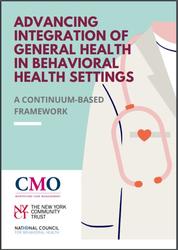NYS Conference of Local Mental Hygiene Directors, Inc. | An Affiliate of the New York State Association of Counties >
Hot Topics / Priority Issues
New Report: Framework For General Health Integration in Behavioral Health Clinics
The National Council for Behavioral Health has distributed a compelling report that provides guidelines to improve access to primary care for those with chronic behavioral health conditions, a problem that has worsened throughout the pandemic.
THE ISSUE
Many providers are implementing approaches to integrate behavioral health care and primary care to treat people with mental health and substance use disorders (SUDs) who struggle to access quality medical care because of increased risk of overweight/obesity, smoking, cardiovascular disease, asthma and diabetes.
This report, “Advancing Integration of General Health in Behavioral Health Settings: A Continuum-based Framework,” was developed to enable behavioral health clinics (mental health and substance use) to plan and implement integration to improve health care outcomes. With funding support from the New York Community Trust, Montefiore led a team of experts from Columbia, UCSF, UPenn and The National Council for Behavioral Health to develop this framework, which describes a series of customizable and concrete implementation steps behavioral health care organizations can employ to advance evidence-based integration practices.
WHY NOW?
Behavioral health clinics can have a difficult time identifying general health conditions due to limited use of general health screening tools, staffing shortages, inadequate training on general health condition management and poorly established relationships between behavioral health and primary care providers.
Without regular primary care, adults with serious mental illness (defined here as recurrent depression or anxiety, bipolar illness and psychotic disorders with a serious functional impairment) often have more emergency department (ED) visits and potentially preventable medical hospitalizations because chronic conditions are not well controlled. Although there are several models of integration that are in the literature, adoption is difficult. This framework brings together the evidence-based steps that a clinic can deploy, taking into account local resources and existing strengths.
Using a multidisciplinary team approach, organizations can use the framework as a self-assessment and then develop a quality improvement plan to advance and deepen their integration initiatives to improve outcomes for people with chronic behavioral health disorders.
THE ROLE OF COVID-19
With the new national challenge of the COVID-19 pandemic, integration is even more important and pressing where primary care access may be more limited. To advance evidence-based integration of general health care in behavioral health settings, clinics have become intensely interested in the underlying steps they can take to implement and advance specific general health practices.
THE SOLUTION
The framework presented in this guide is intended to help clinics develop then implement operational plans customized for their particular circumstance to achieve e?ective, evidence-based integration. This framework focuses on integration of general health in behavioral settings for adult patients. A general health integration framework (GHI) addresses the challenge of the traditional divide between behavioral health and non-behavioral health conditions.
Enhancing behavioral health and primary care integration is critical to improving patient outcomes and quality of life. Learn the eight key domains of integrated care across integration models, which include:
- Screening, referral to care and follow-up.
- Evidence -based care for preventive interventions and common general medical conditions.
- Ongoing care management.
- Self-management support that is adapted to culture, socioeconomic and life experiences of patients.
- Multi-disciplinary team (including patients) with dedicated time to provide general health care.
- Systematic quality improvement.
- Linkages with community/social services that improve general health and mitigate environmental risk factors
- Sustainability.
YOUR NEXT STEP
Read the report here.




